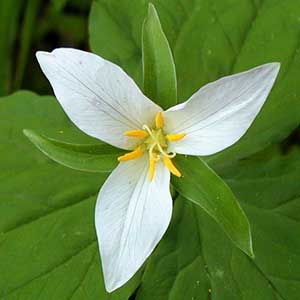Trillium ovatum
Trillium ludovicianum
Pacific trillium, trillium, western trillium, western wake-robin, western white trillium, white or western trillium, white trillium
Louisiana trillium, Louisiana wakerobin
semierect to horizontal, short, stout, praemorse.
± horizontal, brownish, short, thick, praemorse, not brittle.
1–2, round, 2–5 dm, ± slender, glabrous.
1–3, round in cross section, 1.4–2.6 dm, ± slender, glabrous.
sessile, subsessile, or short-petiolate;
blade medium green, sometimes blotched and mottled, main veins prominent, ovate-rhombic, 7–12 × 5–20 cm, continuing to expand during anthesis, base rounded, apex acuminate.
held well above ground, sessile;
blade strongly mottled in dark and bronzy green, often with central light strip, mottling becoming somewhat obscure with age, lanceolate-ovate, 5.3–9.5 × 2.3–5 cm, not glossy, margins of distal 1/3 convex-curved to apex, apex rounded-acute.
erect or nodding, odorless;
sepals spreading to horizontal, green, lanceolate to oblong-lanceolate, 15–50 × 6–20 mm, margins entire, apex acute;
petals erect-ascending, usually wide-spreading from base, exposing entire pistil, white or with pink or blush markings, lacking V-shaped markings, fading to rosy pink, purple, or dark red, veins not deeply engraved, ± linear to widely obovate, 1.5–7 ×1–4 cm, widest at or above middle, thin-textured, margins flat to undulate, apex acuminate;
stamens prominent, slightly recurved-spreading to straight, 10–18 mm;
filaments white, shorter than anthers, slender;
anthers yellow, 4–16 mm, slender, dehiscence latrorse-introrse;
ovary green or white, ovoid, 6-angled, 5–12 mm, attachment ± 3/4 ovary width;
stigmas recurved, barely connate basally, greenish white or white, linear, not lobed adaxially, 6–10 mm, uniformly thin;
pedicel erect to leaning, 2–6 cm.
erect, odor of carrion;
sepals displayed above bracts, spreading, green, lanceolate-oblanceolate, 19–35 × 2.7–4 mm, margins entire, apex rounded or acute to sometimes weakly reflexed;
petals long-lasting, faintly introrsely curved-erect-spreading, weakly connivent, ± concealing stamens and ovary, dark maroon-brown, purplish, or dull greenish, or 2-colored, basal portion purple, distal portion grayish green, not spirally twisted, oblanceolate-linear, 3.5–5.5 × 0.4–0.8 cm, thick-textured, thickened and weakly clawed basally, margins entire, apex acute;
stamens erect, straight, 10–18 mm;
filaments olive-orange, 2–3 mm, widened basally;
anthers erect, straight, olive to orange, 7–20 mm, slender, dehiscence latrorse;
connectives olive to orange, straight, scarcely extended beyond anther sac;
ovary purple, ovoid, 6-angled, 8–9 mm;
stigmas erect, with spreading or coiled tips, distinct, pale purple, subulate, 3–6 mm, ± fleshy.
baccate, green or white, ± odorless, broadly ovoid, obscurely winged, 1.2–2.8 × 0.7–1.9 cm, pulpy-moist.
dark purplish green, little or no odor, ovoid, 6-angled, pulpy.
= 10.
Trillium ovatum
Trillium ludovicianum
Varieties 2 (2 in the flora).
(Discussion copyrighted by Flora of North America; reprinted with permission.)
The range of Trillium ludovicianum is near to that of T. cuneatum in Mississippi, and the two appear to intergrade.
(Discussion copyrighted by Flora of North America; reprinted with permission.)
1. Bracts sessile; petals lanceolate to obovate, 1.5–7 × 1–4 cm | var. ovatum |
1. Bracts distinctly short-petiolate; petals linear to linear-lanceolate, 0.5–2.4 × 0.2–0.6 cm | var. oettingeri |
- Local floras:
BC,
CA,
OR,
WA
- Local Web sites:
CalFlora,
CalPhotos,
Flora NW,
PNW Herbaria,
Turner Photog.
WildflowerSearch
iNaturalist (observations)
USDA Plants Database
- LBJ Wildflower Center
- SEINet
- Plants of the World Online
- Encyclopedia of Life
- Wikipedia
- Google Image Search


